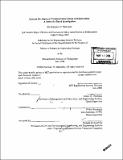System development technical interactions and innovation : a network-based investigation
Author(s)
Makumbe, Pedzisayi O
DownloadFull printable version (6.124Mb)
Other Contributors
Massachusetts Institute of Technology. Engineering Systems Division.
Advisor
James M. Utterback and Kirkor Bozdogan.
Terms of use
Metadata
Show full item recordAbstract
The development of complex engineering systems such as aircraft engines involves many cross functional teams that are usually geographically distributed. These teams interact in several ways but one of the most important set of interactions during the product development phase is the flow of technical information which is largely used for coordination and problem solving. For analytical purposes, these technical information flows can be represented as a directed network. This thesis develops a context and a research design that can help one investigate the impact of the resultant network structure on innovation in complex engineering systems. The broad context can be divided into two: theoretical and real world contexts. The theoretical context is developed by reviewing literature at the intersection of networks and innovation, and the real world context is typified by a modular enterprise developing a complex engineering system. Within this broad context, the research area of interest is framed by a set of hypotheses that lead to precise innovation measures and characterizations. The research design is motivated by the context and intended theoretical contributions. It consists of two major sections. (cont.) The first section discusses and critiques methodologies for constructing networks and proposes a methodology more suited to this engineering systems development context. The second section describes a two-stage model whose variables include network structural properties such as structural holes, nodal degree, tie strength, and innovation output. It also describes a methodology for investigating the relationship between network density and the innovation development subprocess. Finally, the context and research design are tied together to create an instantiation of the measurement and characterization of innovation in complex engineering systems development. The characterization considers product innovation as radical, architectural, modular or incremental, and process innovation as organizational / coordination-based or technical. The measures of innovation include granted patents, implemented employee suggestions, product literature based innovation counts and results from structured interviews with the two leaders from each node in the network.
Description
Thesis (S.M.)--Massachusetts Institute of Technology, Engineering Systems Division, 2006. Includes bibliographical references (leaves 70-77).
Date issued
2006Department
Massachusetts Institute of Technology. Engineering Systems DivisionPublisher
Massachusetts Institute of Technology
Keywords
Engineering Systems Division.